19 photos of Juneteenth celebrations over the years
Published in Slideshow World
Subscribe
19 photos of Juneteenth celebrations over the years
Often called "America's second Independence Day" or "Black Independence Day," Juneteenth commemorates the end of slavery in the United States. It is celebrated annually every June 19 and is the first new federal holiday since 1983, when Martin Luther King, Jr. Day joined the calendar.
But its federal holiday designation in 2021 didn't come out of nowhere. It took decades of organizing by advocates like Opal Lee, the "Grandmother of Juneteenth," and more than a century of Black communities celebrating the holiday locally for then-President Joe Biden to sign Juneteenth into law.
The groundwork for Juneteenth was laid on Jan. 1, 1863, when President Abraham Lincoln's Emancipation Proclamation took effect. Although it declared enslaved Black people in Confederate states to be free, it did not apply to border states or areas of the South under Union control. The proclamation was a wartime measure aimed at weakening the Confederacy's economy and morale by depriving it of enslaved labor.
The law, and the Union's ability to enforce that law, spread slowly throughout the South. On June 19, 1865—over two years after the Emancipation Proclamation went into effect and several months after the 13th Amendment outlawed slavery—Black people enslaved in Galveston Bay, Texas, were granted their freedom.
It's widely believed that Galveston Bay was the last place in the U.S. to still have Black people who were enslaved. The emancipation of these 250,000 individuals meant that all Black Americans were finally free. Communities in Texas began celebrating Juneteenth one year later, in 1866, with church services and community picnics.
For decades, Black people marked the holiday in similar ways. Certain foods, like barbecued meat and strawberry soda, became associated with Juneteenth. Then, on Jan. 1, 1980, Juneteenth became an official state holiday in Texas thanks to the efforts of Black legislator Al Edwards.
Today, Juneteenth celebrates the end of slavery in the U.S. and reminds us how far we still have to go to create a society that provides "liberty and justice for all." Here, Stacker has collected images of Juneteenth celebrations over the years that showcase the holiday's importance and how much it has changed. From Black Panther rallies to historical reenactments, these photos illustrate how varied these celebrations can be.
Visit thestacker.com for similar lists and stories.
Juneteenth at the Lincoln Memorial in 1970
On Juneteenth 1970, the Black Panther Party staged a Revolutionary People's Constitutional Convention with the goal of drafting "a true people's constitution...that takes into account the ethnic and pluralistic nature of this society." One of the largest gatherings of radical leftists in U.S. history, the rally was attended by members of the Black Power, Asian American, Chicano, American Indian, Anti-War, Women's Liberation, and Gay Liberation movements.
Denver youth celebrate Juneteenth at Malcolm X Center in 1972
Traditional Juneteenth spreads include barbecue, soul food, and anything red. The color red represents the blood of Black people who were enslaved and never experienced freedom, as well as the resilience and transformational power of Black people. Here, several celebrants enjoy hot dogs and sodas.
A mother and child watch the Unity March in Houston in 1974
Parades have long been a Juneteenth tradition. Here, a mother and child watch a Unity March heading toward Houston's Hermann Park. Modern-day celebrants can attend Juneteenth parades in places like Atlanta, Philadelphia, and New York City.
Waving to the parade at Denver's Juneteenth in 1989
A young boy watches a Juneteenth parade pass by. Early Juneteenth celebrations would not have been held on public land in this way, particularly in the South, where white authorities used Jim Crow laws to suppress celebrations.
A business owner prepares for a Juneteenth celebration in 1989
Today, you can easily find Juneteenth decorations at party supply stores and big box retailers like Walmart. But before the holiday was federally recognized, few places had specific decorations for the day. Here, a store owner hangs flags in front of his variety shop in the days leading up to the holiday.
A dance troupe performs at the Minneapolis Juneteenth Festival in 1996
For Black people who were enslaved, dance was a way to remain connected to their cultures and roots. Many Juneteenth celebrations now include dance performances, like this one from the First Step troupe in Minneapolis, as a way of honoring those origins and the perseverance of the enslaved.
Children participate in a Juneteenth celebration at DC's Anacostia Museum in 1998
Two children enjoy a Juneteenth carnival with candy and temporary tattoos at Washington D.C.'s Anacostia Museum. Part of the Smithsonian Institution, the community-based museum displays exhibitions about African American history and culture. The Anacostia Museum still operates today and has one of the largest collections of Black historical artifacts in the country.
A libation ceremony at Freedman's Town Cemetery in Houston, in 2003
The Chairman of the Houston Chapter of the National Black United Front pours water on the ground during a Juneteenth "Pouring of Libation" ceremony. In this ritual, a drink is offered to the Creator, sacred ancestors, and the environment. Done in the spirit of remembrance, libation ceremonies appear in many community celebrations of Juneteenth.
Sampling sweet potato pie in Richmond, California, in 2004
Two people taste entries in the sweet potato pie cook-off contest during a Juneteenth celebration in Richmond, California. NPR reports that Black people who were enslaved had been cooking with sweet potatoes for centuries because the tubers are similar to yams, a root vegetable commonly eaten in West Africa. Over the years, dishes like sweet potato pie have become hallmarks of Black cuisine.
A public reading of the Emancipation Proclamation in Galveston, Texas, in 2010
Juneteenth celebrants in Galveston, Texas, listen to a public reading of the Emancipation Proclamation to mark the holiday. Galveston still holds annual public readings of General Order No. 3 today. Back in 1865, Major General Gordon Granger read the order to the people of Galveston, stating, "The people of Texas are informed that, in accordance with a proclamation from the executive of the United States, all slaves are free. This involves an absolute equality of personal rights and rights of property between former masters and slaves."
Miss Juneteenth Pageant winners in Houston in 2011
From Milwaukee to Savannah, communities have held Miss Juneteenth pageants for years. Although these beauty pageants often include traditional events like topical interviews, talent competitions, and scholarship awards, for many contestants, the contests hold a deeper meaning. "It's a reminder that I'm proudly Black and I'm happy about it and I'm strong," one former contestant told the New York Times in 2021. "A reminder that Black is beautiful. To be ourselves with the hate or without the hate that we experience. A reminder that we're free. We're here with a purpose."
Sharing family histories at Oakland's Juneteenth Festival in 2013
A big part of Juneteenth is celebrating family legacies. Here, several generations in Oakland, California, pore over pictures in a Baptist Journal, possibly looking for photos of other family members, a few days before the city's Juneteenth celebrations.
Grilling and gathering at Franklin Park in Boston in 2014
People grill in a Boston park on Juneteenth. Segregation kept Black people out of public parks for years, but some communities created their own parks for the express purpose of celebrating Juneteenth. Houston's Emancipation Park, founded in 1872, is one example of a public space created as a place "for Black communities to gather and mark the jubilation of the end of slavery in the Confederacy."
Juneteenth community spirit on display in Schenectady, New York, in 2016
At a Juneteenth celebration in Schenectady, New York's Central Park, a woman sells t-shirts as part of a local fundraiser. Vendors selling merchandise are a common sight at Juneteenth events. As in this case, proceeds sometimes go toward community causes.
Philadelphia's Juneteenth Parade marches through the city in 2019
Marchers wave a black, green, and red version of the American flag in a Philadelphia Juneteenth parade. The flag, which combines the colors of Jamaican activist Marcus Garvey's pan-African flag with the traditional structure of the American flag, was designed by artist David Hammons. According to the Smithsonian Institution, Hammons has said that "[Garvey's flag] is so abstract, so pure, that the masses were frightened by it. I made my flag because I felt that they needed one like the U.S. flag, but with black stars instead of white ones."
Thousands cross the Brooklyn Bridge in Juneteenth protest in 2020
Thousands of protestors walked across the Brooklyn Bridge on Juneteenth, 2020, as part of the Unite NY 2020, Bringing All of New York Together rally and march for Black Lives Matter. The protest was intended to highlight the institutional racism that exists today in America and illustrate that while slavery ended in 1856, Black Americans still struggle for equality.
A choir performs at Louisville's Juneteenth Festival in 2021
Two choir singers perform during Louisville's Juneteenth Festival in 2021. Songs like "Lift Every Voice and Sing," the unofficial Black National Anthem, often feature heavily in Juneteenth celebrations. The lyrics of the hymn, which was first performed for President Lincoln's birthday in 1900, "eloquently captured the solemn yet hopeful appeal for the liberty of Black Americans," according to the NAACP.
The Juneteenth flag at Reading City Hall in Pennsylvania in 2021
The Juneteenth flag was designed by activist Ben Haith in 1997 and reconfigured into its current form in 2000. The white star in the middle represents freedom and nods to the state of Texas (where Juneteenth began), the bursting outline represents a new beginning for all Black Americans, and the arc represents the new opportunities that lay ahead for Black Americans after slavery was abolished. The red, white, and blue coloring reminds us that those Black people who were enslaved, and their descendants, have always been Americans, even when the law didn't see them that way.
Commemorating the past at the DC Juneteenth People's Parade in 2024
Representatives from the U.S Colored Troops and Buffalo Soldiers, a Maryland organization made up of historians and re-enactors, gather at the Lincoln Memorial to celebrate Juneteenth 2024. In 1866, the Army Reorganization Act created room for permanent Black regiments for the first time. A mix of Civil War veterans, freedmen, and formerly enslaved Black men, these cavalrymen were nicknamed "Buffalo Soldiers" by Indigenous people, both for their appearance and fighting skills.
Story editing by Cu Fleshman. Copy editing by Paris Close.

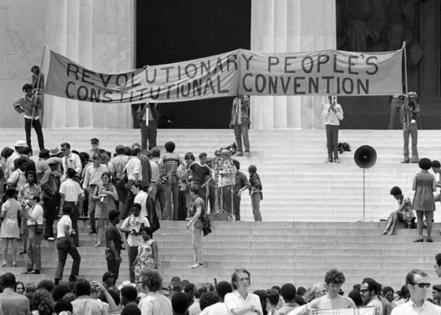
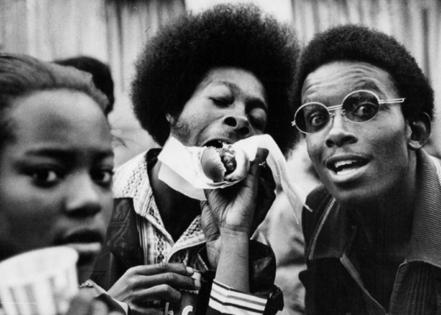
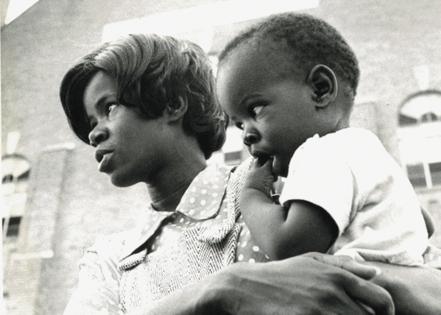
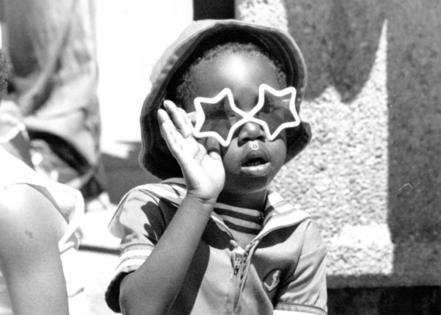
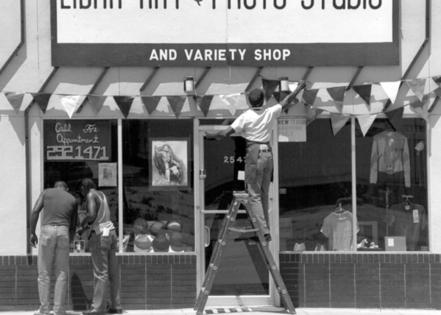
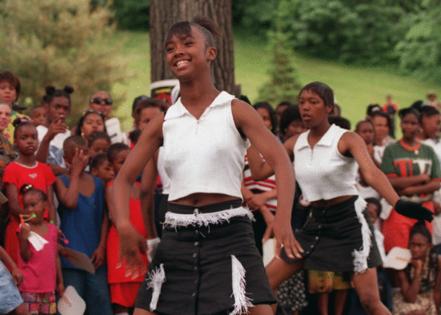
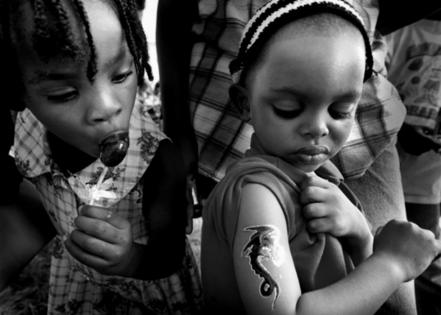
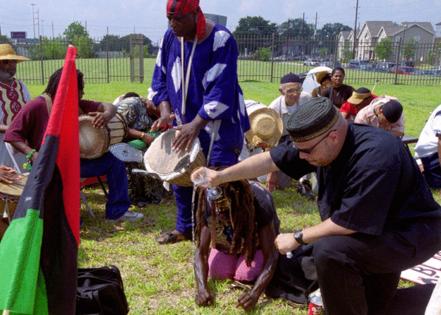
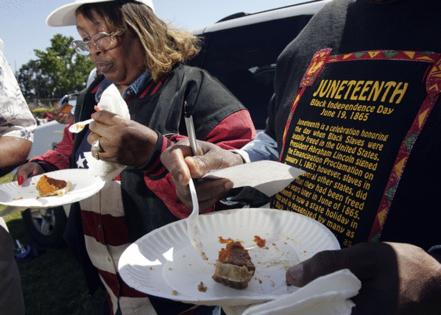
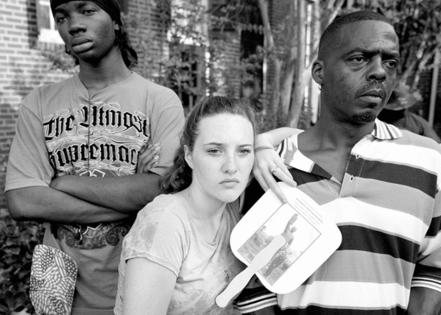
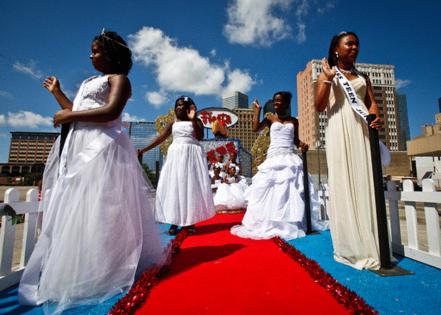
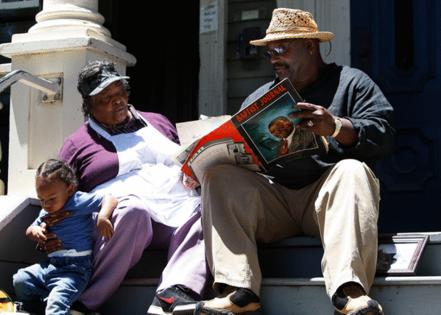
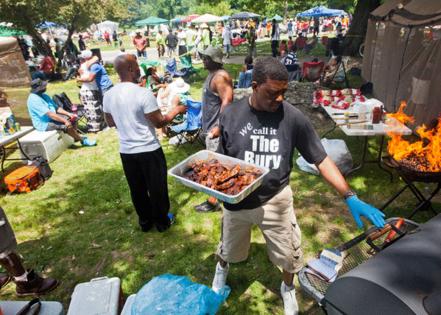
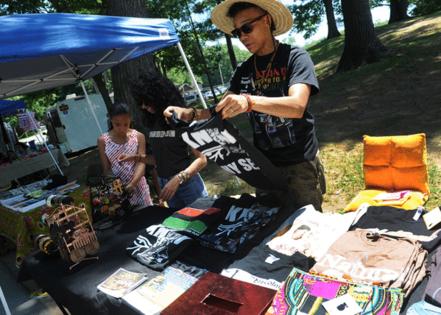
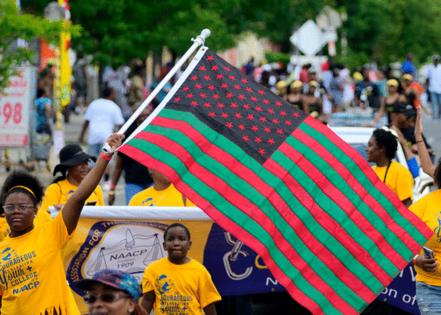
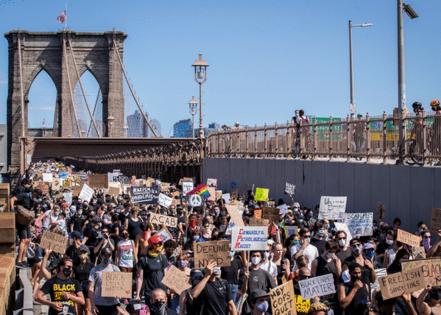
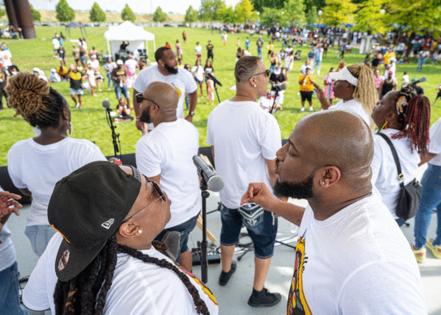

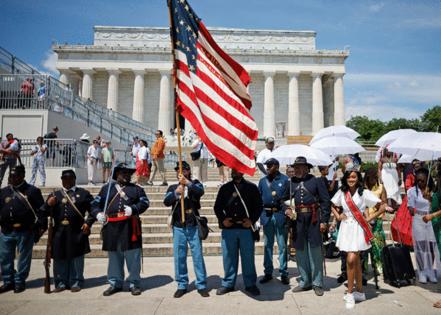
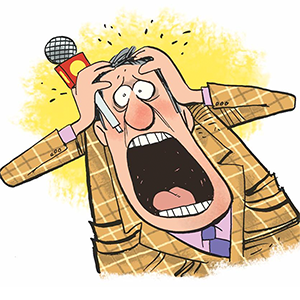



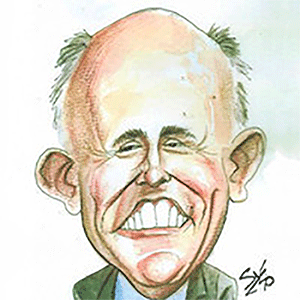

Comments